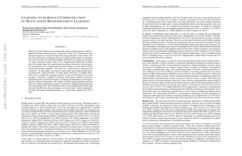A Grid-Based Evolutionary Algorithm for Many-Objective Optimization
Balancing convergence and diversity plays a key role in evolutionary multiobjective optimization (EMO). Most current EMO algorithms perform well on problems with two or three objectives, but encounter difficulties in their scalability to many-objective optimization. This paper proposes a grid- based evolutionary algorithm (GrEA) to solve many-objective optimization problems. Our aim is to exploit the potential of the grid-based approach to strengthen the selection pressure towards the optimal direction while maintaining an extensive and uniform distribution among solutions. To this end, two concepts—grid dominance and grid difference—are introduced to determine the mutual relationship of individuals in a grid environment. Three grid-based criteria, i.e., grid ranking, grid crowding distance, and grid coordinate point distance, are incorporated into the fitness of individuals to distinguish them in both the mating and environmental selection processes. Moreover, a fitness adjustment strategy is developed by adaptively punishing individuals based on the neighborhood and grid dominance relations in order to avoid partial overcrowding as well as guide the search towards different directions in the archive. Six state-of-the-art EMO algorithms are selected as the peer algorithms to validate GrEA. A series of extensive experiments is conducted on 52 instances of nine test problems taken from three test suites. The experimental results show the effectiveness and competitiveness of the proposed GrEA in balancing convergence and diversity. The solution set obtained by GrEA can achieve a better coverage of the Pareto front than that obtained by other algorithms on most of the tested problems. Additionally, a parametric study reveals interesting insights of the division parameter in a grid and also indicates useful values for problems with different characteristics.
PDF Abstract
